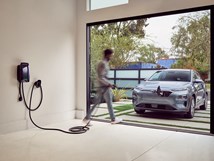Startup Launches Electric London Black Cab
U.K.-based Dynamo Motor Co. has launched an all-electric version of London’s iconic “black cab.”
#hybrid
U.K.-based Dynamo Motor Co. has launched an all-electric version of London’s iconic “black cab.”

The vehicle, which is based on Nissan Motor Co.’s electric e-NV200 Evalia MPV, is said to be London’s first fully electric taxi since Queen Victoria’s reign 120 years ago. That vehicle, known as the Bersey Taxi, was sold only from 1987 to 1989.
Previous reports erroneously referred to London Taxi Co.’s TX5 model, which bowed two years ago, as an EV. But that vehicle employs a small gasoline engine as a generator, which makes it a series hybrid.
Dynamo buys the e-NV200 from Nissan, then modifies it to meet London’s strict taxi regulations. This includes a redesigned interior, wheelchair accessibility and a tighter turning radius. Dynamo also has added a large glass roof and an automated payment system.
The Dynamo Taxi’s electric motor generates 107 hp and 187 lb-ft of torque. A 40-kWh battery can power the vehicle for 187 miles, according to the supplier. The battery can be recharged to 80% capacity in about 50 minutes.
Dynamo aims to assemble more than 500 of the taxis next year and expand to three times that volume in 2021. The vehicle is priced at £55,500 ($71,200) but is eligible for a £7,500 ($9,600) subsidy.
Nissan has sold some 25,000 e-NV200 models in Europe since the EV was launched there in 2014.
RELATED CONTENT
-
On Fuel Cells, Battery Enclosures, and Lucid Air
A skateboard for fuel cells, building a better battery enclosure, what ADAS does, a big engine for boats, the curious case of lean production, what drivers think, and why Lucid is remarkable
-
on lots of electric trucks. . .Grand Highlander. . .atomically analyzing additive. . .geometric designs. . .Dodge Hornet. . .
EVs slowdown. . .Ram’s latest in electricity. . .the Grand Highlander is. . .additive at the atomic level. . .advanced—and retro—designs. . .the Dodge Hornet. . .Rimac in reverse. . .
-
Things to Know About Cam Grinding
By James Gaffney, Product Engineer, Precision Grinding and Patrick D. Redington, Manager, Precision Grinding Business Unit, Norton Company (Worcester, MA)








